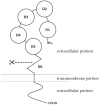Role of Polymeric Immunoglobulin Receptor in IgA and IgM Transcytosis
- PMID: 33668983
- PMCID: PMC7956327
- DOI: 10.3390/ijms22052284
Role of Polymeric Immunoglobulin Receptor in IgA and IgM Transcytosis
Abstract
Transcytosis of polymeric IgA and IgM from the basolateral surface to the apical side of the epithelium and subsequent secretion into mucosal fluids are mediated by the polymeric immunoglobulin receptor (pIgR). Secreted IgA and IgM have vital roles in mucosal immunity in response to pathogenic infections. Binding and recognition of polymeric IgA and IgM by pIgR require the joining chain (J chain), a small protein essential in the formation and stabilization of polymeric Ig structures. Recent studies have identified marginal zone B and B1 cell-specific protein (MZB1) as a novel regulator of polymeric IgA and IgM formation. MZB1 might facilitate IgA and IgM transcytosis by promoting the binding of J chain to Ig. In this review, we discuss the roles of pIgR in transcytosis of IgA and IgM, the roles of J chain in the formation of polymeric IgA and IgM and recognition by pIgR, and focus particularly on recent progress in understanding the roles of MZB1, a molecular chaperone protein.
Keywords: antibody secretion; immunoglobulin A (IgA); immunoglobulin M (IgM); immunoglobulin transcytosis; joining chain (J chain); marginal zone B and B1 cell-specific protein (MZB1); mucosal immunity; polymeric immunoglobulin receptor (pIgR).
Conflict of interest statement
The authors declare no conflict of interest.
Figures


Similar articles
-
The carboxyl-terminal domains of IgA and IgM direct isotype-specific polymerization and interaction with the polymeric immunoglobulin receptor.J Biol Chem. 2002 Nov 8;277(45):42755-62. doi: 10.1074/jbc.M205502200. Epub 2002 Sep 3. J Biol Chem. 2002. PMID: 12213814
-
Identification of a polymeric Ig receptor binding phage-displayed peptide that exploits epithelial transcytosis without dimeric IgA competition.J Biol Chem. 2006 Mar 17;281(11):7075-81. doi: 10.1074/jbc.M508509200. Epub 2006 Jan 19. J Biol Chem. 2006. PMID: 16423833
-
Establishment of a functional secretory IgA transcytosis model system in vitro for functional food screening.Appl Microbiol Biotechnol. 2015 Jul;99(13):5535-45. doi: 10.1007/s00253-015-6501-9. Epub 2015 Mar 18. Appl Microbiol Biotechnol. 2015. PMID: 25776060
-
3D Structures of IgA, IgM, and Components.Int J Mol Sci. 2021 Nov 26;22(23):12776. doi: 10.3390/ijms222312776. Int J Mol Sci. 2021. PMID: 34884580 Free PMC article. Review.
-
Recent advances in the molecular understanding of immunoglobulin A.FEBS J. 2024 Aug;291(16):3597-3603. doi: 10.1111/febs.17089. Epub 2024 Feb 8. FEBS J. 2024. PMID: 38329005 Review.
Cited by
-
Cholecystokinin Outcome on Markers of Intestinal IgA Antibody Response.Curr Issues Mol Biol. 2022 Jun 1;44(6):2542-2553. doi: 10.3390/cimb44060173. Curr Issues Mol Biol. 2022. PMID: 35735614 Free PMC article.
-
Faecalibacterium prausnitzii enhances intestinal IgA response by host-microbe derived inecalcitol in colitis.BMC Med. 2025 Jul 15;23(1):425. doi: 10.1186/s12916-025-04260-2. BMC Med. 2025. PMID: 40660288 Free PMC article.
-
Pig jejunal single-cell RNA landscapes revealing breed-specific immunology differentiation at various domestication stages.Front Immunol. 2025 Feb 28;16:1530214. doi: 10.3389/fimmu.2025.1530214. eCollection 2025. Front Immunol. 2025. PMID: 40151618 Free PMC article.
-
Delayed boosting improves human antigen-specific Ig and B cell responses to the RH5.1/AS01B malaria vaccine.JCI Insight. 2023 Jan 24;8(2):e163859. doi: 10.1172/jci.insight.163859. JCI Insight. 2023. PMID: 36692019 Free PMC article.
-
Multi-Omics Analysis Combined with Machine Learning Identified FABP4 in Smooth Muscle Cells as a Pathogenic Factor in Atherosclerosis.J Inflamm Res. 2025 Jul 26;18:10029-10049. doi: 10.2147/JIR.S519114. eCollection 2025. J Inflamm Res. 2025. PMID: 40740974 Free PMC article.
References
-
- Van Anken E., Pena F., Hafkemeijer N., Christis C., Romijn E.P., Grauschopf U., Oorschot V.M.J., Pertel T., Engels S., Ora A., et al. Efficient IgM Assembly and Secretion Require the Plasma Cell Induced Endoplasmic Reticulum Protein PERp1. Proc. Natl. Acad. Sci. USA. 2009;106:17019–17024. doi: 10.1073/pnas.0903036106. - DOI - PMC - PubMed
Publication types
MeSH terms
Substances
Grants and funding
LinkOut - more resources
Full Text Sources
Other Literature Sources
Miscellaneous

